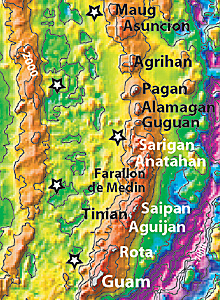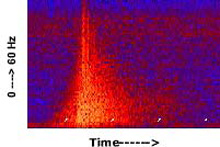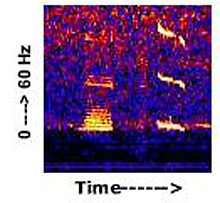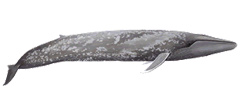
Map view of the bathymetry and hydrophone locations (white stars with black outline) along the Marianas Islands and surrounding region. Yellow-shaded bathymetry shows seafloor less than 1000m deep, green 1000-2000m deep, blue greater than 2000m. Click image for larger view.
Sound in the Deep Sea
Robert Dziak
Seismologist
Oregon State University
![]() Watch an animation of the hydrophone in use. (mp4, 2.8 MB)
Watch an animation of the hydrophone in use. (mp4, 2.8 MB)
Hydroacoustic monitoring (listening to underwater sound) of the Pacific Ocean shows the region to be dynamic and constantly evolving both geologically and biologically. Monitoring ocean sounds has allowed us to listen to the movement of magma through the seafloor during major volcanic eruptions. We have also observed large-scale faults shatter the ocean crust, and monitored seafloor geysers as they change their eruption pattern in response to these seafloor upheavals. Moreover,we have established the geographic variation and distribution of blue whale calls in the North Pacific.
We plan to focus our most recent efforts on hydroacoustic monitoring of the Marianas Islands—a long archipelago made up of both submerged volcanoes and fiery mountains. The area has been shown to be acoustically lively, exhibiting numerous earthquakes and loud humming sounds produced by movement of red-hot magma through conduits in the seafloor.
As part of the submarine Ring of Fire that encircles the Pacific Ocean, the Marianas Islands are a geologic area called “island-arc volcanoes.” Island-arc volcanoes are produced when one great tectonic plate (the Pacific Plate) is pushed beneath another great plate (Philippine Sea). The Marianas volcanoes resulted from 1) melting of the Pacific Plate as it descended into the Earth’s mantle, then 2) melted plate material rising up through, and erupting onto, the overriding Philippine Sea Plate.
Typically, island-arc volcanoes are places that produce vast numbers of earthquakes, seafloor volcanic eruptions, and extensive fields of seafloor hotsprings (called hydrothermal vents). Previous maps of the Marianas Islands indicate that several submarine volcanic eruptions have taken place there in the recent geologic past, undoubtedly wreaking tremendous havoc on the fragile ecosystems in and around the seafloor hydrothermal vent systems.
What is Hydroacoustics?
Hydroacoustics is the study of sound in water. Because of the physical properties of the ocean, light waves cannot travel far before their energy is absorbed. Sound waves, on the other hand, travel great distances underwater without losing strength, thus making sound a very effective method for observing geological and biological phenomena in the ocean. We use a series of underwater microphones (called hydrophones) to listen to these natural phenomena and find out where in the ocean they occur.

This diagram, called a spectrogram, shows the acoustic signal of a typical earthquake recorded on a hydrophone. The horizontal axis of the hydrophone record is time (white ticks are 1-minute intervals), the vertical axis is frequency (from 0 to 60 Hz), and the colors represent the varying strength of the earthquake’s acoustic energy. Typically, an earthquake produces a triangular-shaped signal on a spectrogram with the highest acoustic energy (yellows and reds) occurring in the 5 to 30 Hz frequency range.
Listening to the Western Pacific Ocean
Since 1991, the NOAA Vents Program has performed hydroacoustic monitoring of the Pacific Ocean using a set of U.S. Navy hydrophones called the SOund SUrveillance System (SOSUS). Unfortunately, the SOSUS array is not situated close enough to the Marianas Islands to hear all the sounds we want to detect. Therefore, we have developed a new instrument called an Autonomous Underwater Hydrophone (AUH) that can be deployed off a ship at any spot in the ocean where we want to listen.
The AUH instrument package is anchored to the seafloor, and a floatation device suspends the hydrophone in the ocean. By studying the frequency characteristics of the sound signals recorded by the hydrophones, we can glean a large amount of geological and biological information.
Frequency is the amount of time it takes for successive peaks of a sound wave to pass by an observation point. It is measured in units of cycles per second, commonly referred to as Hertz (Hz). Humans generally can hear sound waves with frequencies between 20 and 20,000 Hz. Below 20 Hz, sounds are referred to as infrasonic; sounds above 20,000 Hz are ultrasonic. With our hydrophones, we have recorded the very low-frequency, infrasonic signals of earthquakes, volcanic eruptions, and blue and fin whale calls, as well as the audible sounds of passing ships, and the background rumble of passing storm systems.
The Leviathan’s Call
Many species of whales have been sighted near the Marianas Islands, but few if any have been recorded there. One is the blue whale, which grows up to 160 tons and 100 feet long, and is the largest animal ever to inhabit the earth. It makes very intense low-frequency sounds that can be heard tens to hundreds of kilometers away. Blue whales were hunted to near-extinction in the North Pacific up through the 1960s, and a sighting is still a relatively rare event. Populations of blue whales that use different call signatures are known in the eastern and central parts of the North Pacific, but it is unknown whether there are other signature(s) in the western part of this ocean.

Spectrogram of a Northeast Pacific blue whale call. Northeastern Pacific blue whale calls are perhaps the best known blue whale call to date. They generally consist of two parts, A and B. The A call is a series of pulses (on the order of 1.5 pulses/s) which often exhibits side-banding, while the B call is a long FM moan. These calls have been recorded from offshore Vancouver Island B.C., Washington, Oregon, California and off Mexico in the Gulf of California and in the Eastern Tropical Pacific.
The fin whale, the second-largest animal, also makes intense low-frequency sounds that can be heard nearly as far away as blue whales. Fins also make different calls in different parts of the world. Sounds of fin whales from the western North Pacific would enable us to explore their acoustic behavior and biology in a way that no one has before.
We have also heard sounds in this area from other great whales, including sperm, minke, humpback, and Bryde's whales. Most whale calls are typically recorded by hydrophones elsewhere in the North Pacific during the late summer, fall and early winter months. Placing hydrophones in the Marianas region would enable us to explore these rare and unique species.


















